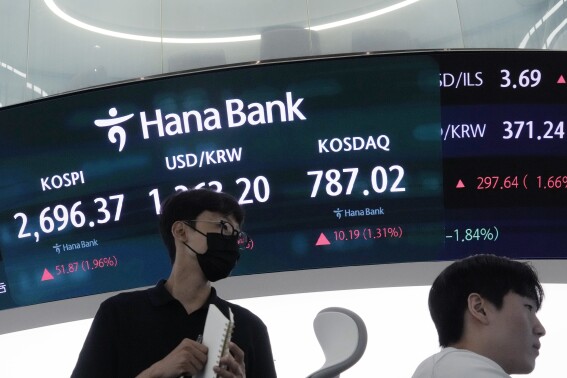Never before has the US entered an economic downturn with a combined federal, state, and local budget deficit anywhere near 8pc of GDP. It is a global accident waiting to happen.
The public accounts should be near balance at this stage of the cycle, years into a long economic expansion. If the US tips into a serious recession from such a depraved starting point, the figure could explode into the mid-teens, regardless of who wins the elections in November.
Chronic debt issuance on this scale would strain the world’s appetite for US Treasuries, blunting the ability of the US government to fight a prolonged slump with countercyclical stimulus. It would have powerful knock-on effects through the world’s dollarised financial system, playing havoc with a whole architecture of global credit contracts linked to US debt yields.
“The US has always been special but it is now testing the limits. Everything has held together so far but the last two Treasury auctions have been very weak, and we’re watching it closely,” said Torsten Slok, chief economist at Apollo Global Management.
Fiscal excess was a latent theoretical danger as long as the US economy was booming. It has come into sharper focus after the US recession scare this month. “In a bad economy, tax revenues go down and unemployment benefits go up. That is when you see fiscal risk,” said Mr Slok.
There is no longer any emergency to justify the current scale of wartime borrowing. You could say that industrial and clean-tech rearmament against China has a belligerent flavour. But Ronald Reagan out-armed the Soviet Union and won the Cold War with combined deficits running below 2pc of GDP in the late 1980s, and that included 15 aircraft carrier battle groups.
Reagan left office with a gross federal debt of under 50pc of GDP. Today it is 122pc and going parabolic.
There is much ruin in a great nation but America is pushing its luck. Structural borrowing on this scale to fund consumption is evidence of a decadent society that has lost all self-discipline.
“Markets could at some point question fiscal sustainability. We know from experience that things look sustainable until, suddenly, they no longer do,” said Claudio Borio, veteran economist at the Bank for International Settlements. He was too tactful to single out the US but we can guess who he was talking about.
Whether or not the US is close to recession is a matter of hot debate. Soaring retail sales in July have again allayed fears, but this shopping rush was possible only because the personal savings rate has crashed to 3.4pc, much as it did in the final months of 2007 before the onset of the Great Recession. When the saving rate is so low, the snap-back is even harder. It is a warning sign, not a sign of strength.
I give more weight to symptoms of late-cycle exhaustion in the US labour market. Job lay-offs can set off a recessionary snowball very fast, unless the US Federal Reserve preempts the process with proactive measures. It has not done so yet.
The Fed’s policy of “data dependency” leaves it hostage to lagging indicators – ie. services inflation – and almost guarantees that it will react too late once the economy does roll over.
US Treasuries are still the world’s safe-haven asset in a global crisis or a recession shock. Markets still crave liquid Treasury bills, notes, and bonds when serious trouble hits. Long-dated debt can generate big profits for investors as nominal yields (not necessarily real yields) fall hard in an economic contraction. But that is a tactical “opportunistic” play for hedge funds.
The critical issue is what happens months and years into the downturn as galactic debt issuance saturates a distrustful market. The near certainty is that the US will have to pay an ever higher borrowing penalty to draw buyers. That will accelerate the vicious feedback loop already corrupting US debt dynamics.
Fitch Ratings estimates that the combined US federal, state, and local deficit was 8.8pc of GDP last year and will be 8.2pc this year. The interest cost will reach 10.3pc of revenues by 2025, three times the median AA-rated country. Anything above 10pc is a red alert.
The immediate causes are Donald Trump’s unfunded tax cuts and Joe Biden’s unfunded spending. The deeper cause is the growth of untouchable middle-class welfare for baby boomers, chiefly pensions and post-65 Medicare.
The Congressional Budget Office says the deficit will be $1.6 trillion (£1.24 trillion) this fiscal year, $1.8 trillion next year, $2.6 trillion by 2034, unless Congress grasps the nettle. That assumes trend economic growth. It would be far higher in a recession.
Net interest is already larger than the US defence budget. It was 1.2pc of GDP a decade ago. It will be 3.4pc this year, and will ratchet steadily higher from there.
Foreign central banks have been dialling down their holdings of US Treasuries for several quarters: some forced to sell in order to defend their currencies, others acting for geopolitical reasons or to seek better returns. The G7 seizure of Russia’s hard currency reserves has horrified the central banks of the Global South.
China has cut from $939bn to $767bn over the last two years. The share of the US Treasury market held by foreign central banks has fallen from 25pc in 2019 to 14pc this year. Private buyers are picking up the slack for now but that, too, is coming into doubt.
Japan’s vast pension funds and life insurers have barely begun to repatriate funds as the Bank of Japan finally raises interest rates, narrowing the yield gap that sustains the yen carry trade. The US Treasury can no longer count on this blue-chip demand to soak up debt issuance. We may not be far from the crossover point where the Japanese become net sellers.
The $1.9 trillion US bond fund Pimco is already diversifying out of US debt and into the relative safe-havens of Australia, Canada and even the UK – a remarkable change in post-Truss perceptions, or perhaps it tells us that the Truss episode was never what it seemed to be.
In my view, the Fed will again be forced to step in to buy US debt, this time suppressing Treasury yields by brute force as they did for nine years between 1942 and the Treasury-Fed Accord of 1951.
They capped short-term bills at 0.375pc and long-term bonds at 2.5pc. Since inflation was running at 20pc, by the end it was naked expropriation of existing bondholders. But at least that was a temporary expedient until America could put its house in order. America is doing no such thing this time.
The Fed will have trouble justifying a return to quantitative easing (QE) so soon after letting the inflation genie out of the bottle. But never underestimate the chutzpah of central bankers. The Fed could argue that it must act to stop future inflation falling much below 2pc or to fend off a deflationary import shock from China. It would of course eschew the term QE, calling it dynamic yield curve control, or some such beauty borrowed from the Bank of Japan.
The bond purchases would in reality be overt monetary financing of Treasury debt. A clean sweep Trump 2.0 presidency might compel it by amending the Federal Reserve Act. A Harris presidency would end up in much the same place by necessity.
What begins as permanent fiscal disorder evolves into permanent monetary disorder. This is where America is now heading at a brisk trot.
No other country or bloc is yet capable of anchoring the international currency and credit system. No other currency is ready to displace the dollar. We will all have to live with a drunken hegemon.
Disclaimer: The copyright of this article belongs to the original author. Reposting this article is solely for the purpose of information dissemination and does not constitute any investment advice. If there is any infringement, please contact us immediately. We will make corrections or deletions as necessary. Thank you.



